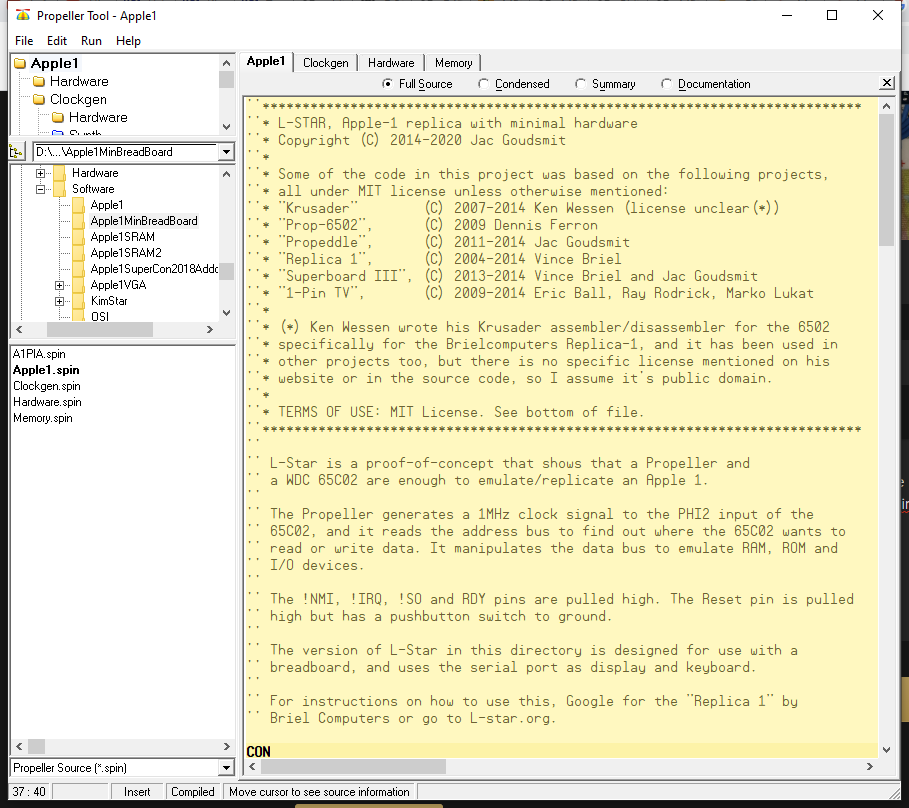-
11Downloading the Firmware
The firmware for the breadboard version of the L-Star project is at https://github.com/jacgoudsmit/L-Star/tree/master/Software/Apple1MinBreadBoard. The easiest way to install the firmware is to install the Propeller Tool and load the Apple1.spin file, then use the F11 key on your keyboard to download it into the EEPROM on the FLiP.
![]()
The project in the Apple1.spin source file in the "Apple1MinBreadboard" directory is different from the other Apple1 projects, in that it uses the serial port as keyboard and monitor, and nothing else. You can use the Parallax Serial Terminal that comes with the Propeller Tool to connect to the Propeller on the FLiP module, by hitting the F12 key.
![]()
Make sure the Baud Rate is set to 115200, and you selected the correct COM port (if you hit F7 in the Propeller tool, it will tell you which COM port you need). And make sure the terminal is Enabled (it disables itself when you activate another program).
But most of all: Make sure your caps lock is on: Woz Mon only understands upper case text.
You can reset the FLiP module by pushing the little button on the edge of the board, on the left side. But you can also toggle DTR on, then off again in the terminal, to reset the Propeller.
You should see the Propeller announcing that it's running the L-Star project, and how much ROM and RAM it's emulating to the 6502. After that, the Propeller initializes the various emulations and everything you see on the screen and type into the terminal, is received from and sent to the Apple 1 Software Defined Computer via the PIA emulation.
The first time you power up the L-Star, the 6502 won't start running automatically. WDC designed the processor so it's usually (always?) in some stuck mode where it doesn't execute instructions when you power it up. So you'll have to push the button you installed on the breadboard to start the 6502. Once the 6502 is running, the L-Star firmware uses a trick to make the 6502 reset, even though the reset line is not actually connected to the Propeller.
The first thing that the 6502 shows you is the backslash character. If you see that after pushing the 6502 reset button, it means it's working! The backslash is actually the error prompt of Woz Mon, the tiny (256 bytes) program that Steve Woz wrote for the original Apple 1 and kindly made available to Vince Briel for the Replica 1.
Woz Mon allows you to do three things: Inspect memory, modify RAM, and run a program. It's the bare minimum, but it was enough to get started in 1976. Obviously we expect a little more from a computer nowadays but thanks to Vince Briel at Brielcomputers and his Replica 1 project, and Ken Wessen who wrote an interactive assembler for the Replica 1, there is a lot more you can do with the L-Star "straight out of the box" than with the original Apple 1.
And the advantage of L-Star is of course that you don't even have to own an EPROM programmer to change the ROM: all you need is to change the file that gets mapped into the 6502 memory. An important alternative ROM image is right there in the directory: it's a ROM that contains a version of AppleSoft BASIC (really Microsoft BASIC) that was ported from the Apple 2 to the Apple 1 recently, instead of the Woz BASIC. Unlike Woz BASIC, AppleSoft BASIC can use floating point and arrays, and produces a listing format that you can capture in your terminal program, and send back to the L-Star without modifications to save and load programs.
L-Star: Software-Defined 6502 Computer
Replicate an Apple-1. Or an OSI Challenger. Or something else. Design your own 6502 computer by programming it.
 Jac Goudsmit
Jac Goudsmit

Discussions
Become a Hackaday.io Member
Create an account to leave a comment. Already have an account? Log In.